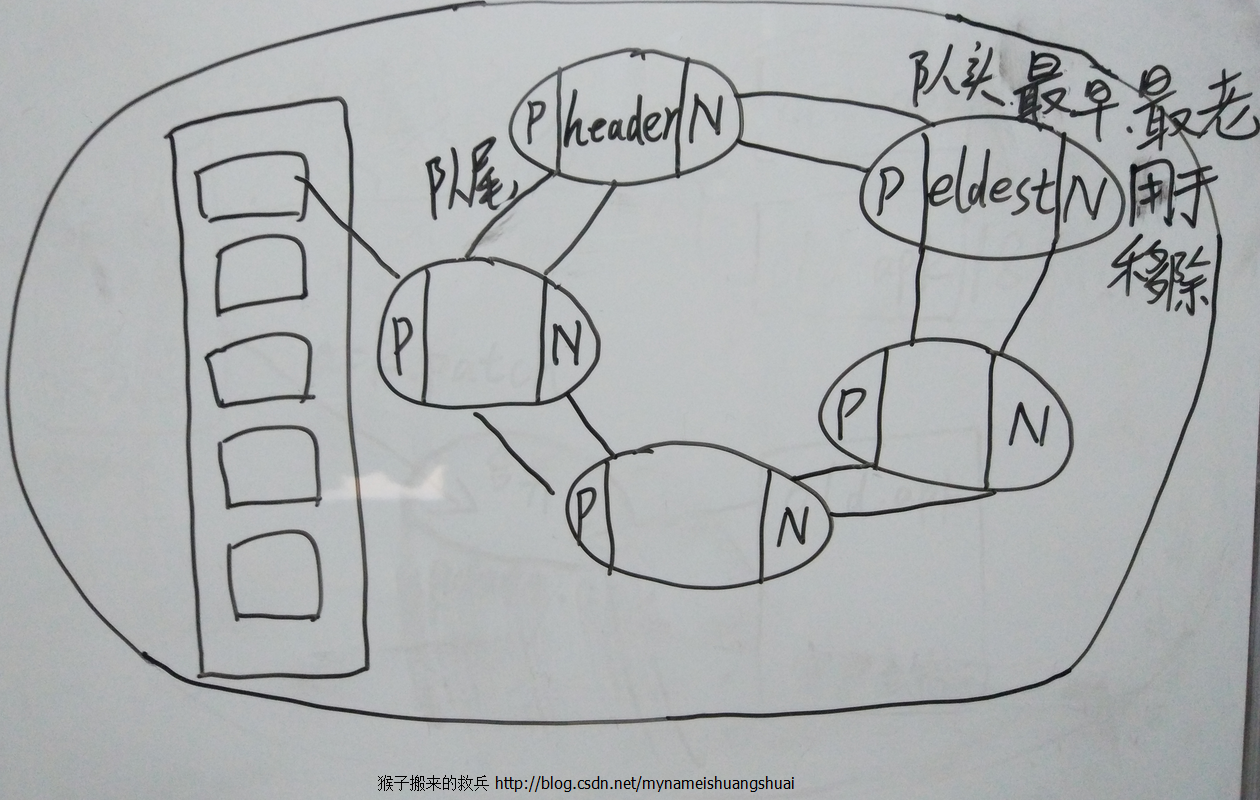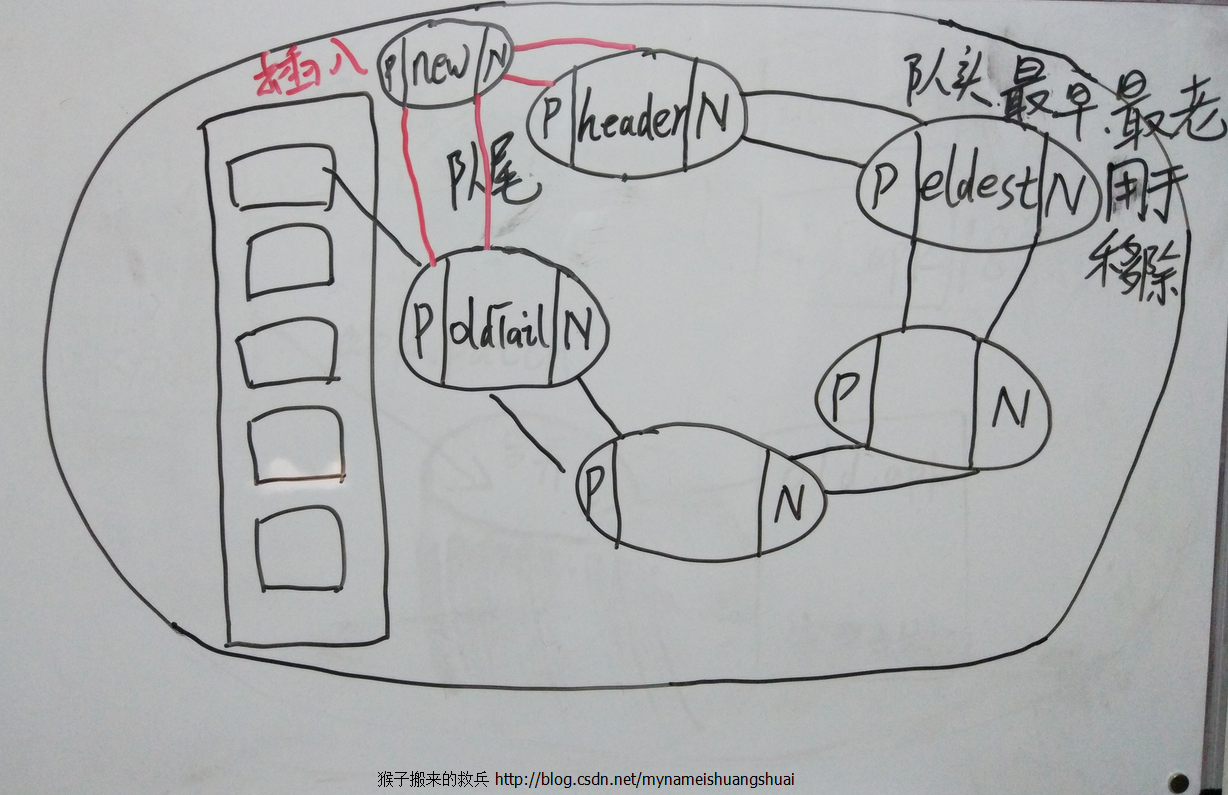线性表数据结构解读(六)链式哈希表结构-LinkedHashMap
2016-12-10 00:00
429 查看
上一篇文章我和大家一起解读了HashMap的原理源码,各位童鞋可以点击链接查看线性表数据结构解读(五)哈希表结构-HashMap
这次我们一起来看一下LinkedHashMap,它保留插入的顺序,如果需要输出的顺序和输入时的相同,那么就选用LinkedHashMap。就LinkedHashMap而言,它继承了HashMap,底层使用哈希表与双向链表来保存所有元素。其基本操作与父类HashMap相似,它通过重写父类相关的方法,来实现自己的链接列表特性。
LinkedHashMap是Map接口的哈希表和链接列表实现,具有可预知的迭代顺序。此实现提供所有可选的映射操作,并允许使用null值和null键。此类不保证映射的顺序,特别是它不保证该顺序恒久不变。
LinkedHashMap实现与HashMap的不同之处在于,后者维护着一个运行于所有条目的双重链接列表。此链接列表定义了迭代顺序,该迭代顺序可以是插入顺序或者是访问顺序。
第一种和队列一样默认是按插入顺序排序,先进来的是最老的元素,放在队头,将来会被先移出去,最后进来的是新的元素。
第二种,基于访问排序,那么调用get方法后,会将每次访问的元素移至队尾,将来移除的时候移除的是队头,最先访问的元素最后才被移除,不断访问可以形成按访问顺序排序的链表。
下图是我在小黑板手绘的双链回环循环链表

下面我们一起来分析一下LinkedHashMap的源码:
下图是我在小黑板手绘的插入方法实现原理图,注意其中指针的变化:

下面博文,我将为大家带来LinkedHashMap的最佳实践:LruCache缓存算法的解析,敬请查阅LinkedHashMap最佳实践:LruCache
这次我们一起来看一下LinkedHashMap,它保留插入的顺序,如果需要输出的顺序和输入时的相同,那么就选用LinkedHashMap。就LinkedHashMap而言,它继承了HashMap,底层使用哈希表与双向链表来保存所有元素。其基本操作与父类HashMap相似,它通过重写父类相关的方法,来实现自己的链接列表特性。
LinkedHashMap是Map接口的哈希表和链接列表实现,具有可预知的迭代顺序。此实现提供所有可选的映射操作,并允许使用null值和null键。此类不保证映射的顺序,特别是它不保证该顺序恒久不变。
LinkedHashMap实现与HashMap的不同之处在于,后者维护着一个运行于所有条目的双重链接列表。此链接列表定义了迭代顺序,该迭代顺序可以是插入顺序或者是访问顺序。
第一种和队列一样默认是按插入顺序排序,先进来的是最老的元素,放在队头,将来会被先移出去,最后进来的是新的元素。
第二种,基于访问排序,那么调用get方法后,会将每次访问的元素移至队尾,将来移除的时候移除的是队头,最先访问的元素最后才被移除,不断访问可以形成按访问顺序排序的链表。
下图是我在小黑板手绘的双链回环循环链表

下面我们一起来分析一下LinkedHashMap的源码:
初始化及构造方法
/** * 双链回环循环链表 */
public class LinkedHashMap<K, V> extends HashMap<K, V> {
/** * 双向链表的头结点 */
transient LinkedEntry<K, V> header;
/** * true通过访问来排序,false通过插入排序 */
private final boolean accessOrder;
/** * Constructs a new empty {@code LinkedHashMap} instance. */
public LinkedHashMap() {
init();
accessOrder = false;// 默认是插入排序
}
public LinkedHashMap(int initialCapacity) {
this(initialCapacity, DEFAULT_LOAD_FACTOR);
}
public LinkedHashMap(int initialCapacity, float loadFactor) {
this(initialCapacity, loadFactor, false);
}
public LinkedHashMap(
int initialCapacity, float loadFactor, boolean accessOrder) {
super(initialCapacity, loadFactor);
init();
this.accessOrder = accessOrder;
}
public LinkedHashMap(Map<? extends K, ? extends V> map) {
this(capacityForInitSize(map.size()));
constructorPutAll(map);
//LinkedHashMap重写了init()方法,在调用父类的构造方法完成构造后,进一步实现了对其元素Entry的初始化操作
@Override
void init() {
header = new LinkedEntry<K, V>();
}
/** * 继承HashMap的Entry元素,又保存了其上一个元素before和下一个元素after的引用 */
static class LinkedEntry<K, V> extends HashMapEntry<K, V> {
LinkedEntry<K, V> nxt;
LinkedEntry<K, V> prv;
/** Create the header entry */
LinkedEntry() {
super(null, null, 0, null);
nxt = prv = this;
}
/** Create a normal entry */
LinkedEntry(K key, V value, int hash, HashMapEntry<K, V> next,
LinkedEntry<K, V> nxt, LinkedEntry<K, V> prv) {
super(key, value, hash, next);
this.nxt = nxt;
this.prv = prv;
}
}
/** * 拿到最老的元素 * Returns the eldest entry in the map, or {@code null} if the map is empty. * @hide */
public Entry<K, V> eldest() {
LinkedEntry<K, V> eldest = header.nxt;
return eldest != header ? eldest : null;
}
}addNewEntry方法
/** * 重写了HashMap中的添加新元素方法 */
@Override
void addNewEntry(K key, V value, int hash, int index) {
// 找到头结点
LinkedEntry<K, V> header = this.header;
// 找到用于移除的队头的最老结点
LinkedEntry<K, V> eldest = header.nxt;
// 如果最老的结点不等于头结点(有元素存在)且removeEldestEntry为true
if (eldest != header && removeEldestEntry(eldest)) {
remove(eldest.key);// 移除最老元素key
}
// Create new entry, link it on to list, and put it into table
// 使用双向链表的套路实现插入,基于访问排序
LinkedEntry<K, V> oldTail = header.prv;
LinkedEntry<K, V> newTail = new LinkedEntry<K,V>(
key, value, hash, table[index], header, oldTail);
table[index] = oldTail.nxt = header.prv = newTail;// 把新的加入到table数组中
}下图是我在小黑板手绘的插入方法实现原理图,注意其中指针的变化:

remove方法
// 移除最老的元素
protected boolean removeEldestEntry(Map.Entry<K, V> eldest) {
return false;
}get方法
/** * Returns the value of the mapping with the specified key. * @param key the key. * @return the value of the mapping with the specified key, or {@code null} * if no mapping for the specified key is found. */
@Override public V get(Object key) {
/* * This method is overridden to eliminate the need for a polymorphic * invocation in superclass at the expense of code duplication. */
if (key == null) {
HashMapEntry<K, V> e = entryForNullKey;
if (e == null)
return null;
if (accessOrder)// 判断排序模式
makeTail((LinkedEntry<K, V>) e);
return e.value;
}
int hash = Collections.secondaryHash(key);
HashMapEntry<K, V>[] tab = table;
for (HashMapEntry<K, V> e = tab[hash & (tab.length - 1)];
e != null; e = e.next) {
K eKey = e.key;
if (eKey == key || (e.hash == hash && key.equals(eKey))) {
if (accessOrder)
makeTail((LinkedEntry<K, V>) e);
return e.value;
}
}
return null;
}下面博文,我将为大家带来LinkedHashMap的最佳实践:LruCache缓存算法的解析,敬请查阅LinkedHashMap最佳实践:LruCache
相关文章推荐
- 线性表数据结构解读(六)链式哈希表结构-LinkedHashMap
- 线性表数据结构解读(五)哈希表结构-HashMap
- [C++]数据结构:线性表的公式化描述和链式描述的结构特点与基本操作
- c/c++常用算法(2) -- 数据结构(线性表的链式存储)
- 数据结构实验之查找七:线性之哈希表
- SDUT 3379 数据结构实验之查找七:线性之哈希表
- 数据结构:线性表的链式存储
- 【数据结构】顺序哈希表与链式哈希表
- 数据结构之线性表-链式存储之静态链表(二)
- 数据结构实验之查找七:线性之哈希表
- 数据结构笔记3 线性表的链式表示
- 数据结构(2):线性表的链式表示和实现
- 数据结构教程 第八课 线性表的链式表示与实现
- SDUT 数据结构实验之查找七:线性之哈希表
- 数据结构之线性表的链式存储
- 数据结构(4)之线性表之单链式存储
- 数据结构之线性表-链式存储之单链表(一)
- 数据结构之线性表――链式存储结构之单链表(php代码实现)
- 数据结构中链式存储的注意点(线性与栈)
- 数据结构实验之查找七:线性之哈希表 151 268
